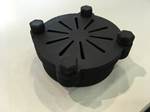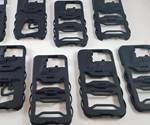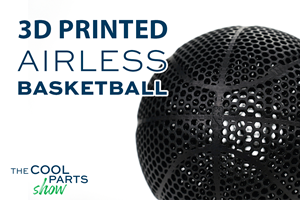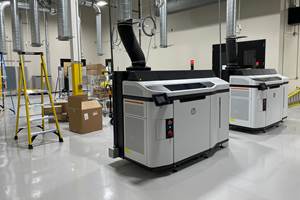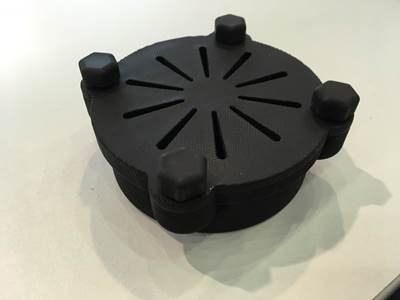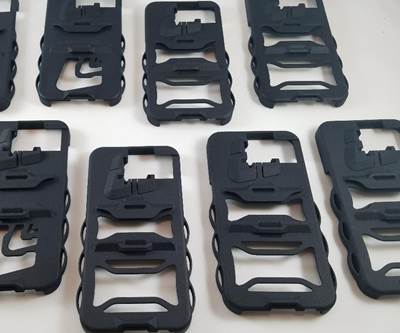How to Calculate the Full Cost of Additive Manufacturing Versus Injection Molding
A true evaluation of additive includes a look at materials, speed, quality, scalability and cost. Bruce Bradshaw of Evolve Additive Solutions explains how to evaluate AM in an injection molding environment in terms of these 5 factors.
For any technology to break through in broad-based manufacturing, there are five categories that potential users must have confidence in: material, speed, quality, scalability and cost. At least that’s what Evolve Additive Solutions Chief Business and Marketing Officer Bruce Bradshaw believes after working with manufacturers across the globe throughout the past couple of years. And, he makes a strong case.
“Additive is such a great technology, but when you start to talk about manufacturing, there are many challenges to consider for companies before they make a switch to a new process like additive manufacturing,” Bradshaw says.
For example, a company might have a champion for additive for a particular product, but can that company secure the buy-in of the CEO, manufacturing manager, VP of manufacturing, the CFO and five product line managers to switch the production line? Here, I’m speaking about volume manufacturing and cost-effective customization for companies engaged in low-volume injection molding, which could be a 50,000-part run or a million parts a year, not 500 or 1,000 units.
How To Calculate the Cost of Additive Manufacturing Versus Injection Molding
Often companies limit their additive technology options for manufacturing because they are unable to address these five crucial factors when calculating the full cost (and benefit) of additive manufacturing for each process considered. Here is a simple breakdown of each of the five:
1. Materials. Bradshaw notes that there are two primary concerns with additive materials today: (1) photoresin material is not the same material used in production and (2) most additive solutions in thermoplastics are relegated to either semicrystalline materials like nylons or amorphous materials like ABS; as an example, selective laser sintering (SLS) really only does semicrystalline, and FDM struggles to go beyond amorphous
“Users want broader solutions. They want to be able to use the same materials they are using in their injection molding machine in their additive machine,” Bradshaw says.
This is the promise of Evolve’s Selective Thermoplastic Electrophotography Process (STEP) technology. STEP lays down an image using electrophotography, then the toner statically jumps to a drum and from the drum to a belt to image a layer. Next, it uses heat, pressure and cooling to form the part. Think injection molding, which also uses heat, pressure and cooling to form a part. Evolve's STEP process does the same thing, but layer by layer. It replicates injection molding with a micro-size layer capability.
“It is not injection molding, but it does mimic it in terms of how it fuses a layer with the growing part,” Bradshaw says. This process is what will allow Evolve to offer material flexibility in the future, as the technology is still in alpha stage testing to identify all possible issues before releasing the product to everyday users or the public.
2. Speed. The STEP process offers speed in terms of process performance, including printing and postprocessing of the part, as well as time to market. Companies want material properties and characteristics similar to injection molding. Additive systems, in general, bring a product to market faster, but when a company wants to produce a million parts a year it needs to ask, how does the system perform? Is the system capable of volume production? How many parts can the printer produce in what period? How much manual intervention and post processing does a system require?
For example, Evolve’s system offers soluble support removal, eliminating the need for an oven or cool-down time. A system may create a full build fast, but the real answer lies in the question, "How quickly can I have a part in my hand?"
Users want broader solutions. They want to be able to use the same materials they are using in their injection molding machine in their additive machine.
3. Quality. The Achilles heel of additive manufacturing is typically the Z axis, as systems print layers and the weak point is typically between the layers. However, Evolve’s process fuses a part, and even though it is pulling heat out in each layer (about ten layers down there's still heat in a part), reptation entanglements occur between the material during the build process, resulting in a part void of layer lines. “The process uses pressure like injection molding and heat to form the part, so the part does not suffer from the layer line, or the Z-axis issue like most additive systems do,” Bradshaw says.
Customers want the surface finish and mechanical part properties they can achieve with injection molding because that is what they are used to in manufacturing. “Now, can a customer find a part for which they don't necessarily need both surface finish and mechanical properties for a niche application? Sure, but they may have an issue when trying to produce the next 10 applications using that process,” Bradshaw says.
4. Scalability. Can the additive process scale? Does the process require a lot of manual intervention? How many people are necessary to use the system and produce a quality part? What shopfloor space is required for the process, such as a room off to the side due to the odor or amount of powder in the air? The ideal system needs to fit into the current facility.
For example, Evolve’s system fits into a manufacturing environment. “The 2D printer that we're leveraging from Kodak for our imaging engine is used in a manufacturing or production environment in 2D printing already. Kodak designed it so that 70 percent of the components are operator replaceable, which means a company often doesn’t need a maintenance expert to come in to fix it. An operator is trained on how to change certain components and is back up and running producing revenue for the company,” Bradshaw says.
Then there is software integration. Integrating the data that comes from the machine to the dashboard that runs the company’s injection molding and CNC machines is important. “Users don’t want to learn a new dashboard that only works with one system,” Bradshaw says.
Users want to be able to capture the number of parts the system printed; specific jobs queued up on the printer, the amount of material in inventory, the number of printed layers, the location of voids in the print, etc. And we can’t forget the Internet of Things, which is driving the capability of systems to accept an order via the web, for example, which then triggers a job, automatically selects the right material, etc.
Evolve is currently two years away from commercialization, but the company is building open APIs (application program interface code that allows two software programs to communicate with each other) by connecting to an organization’s established software platform—like Siemens, Oracle and SAP or even a customized system often used to feed STEP data. This agenda plays nicely with a plethora of homegrown MES and enterprise resource planning (ERP) systems.
If a company is going to seriously consider additive in a manufacturing environment for many projects, they need to hit on all five factors: materials, speed, quality, scalability and cost.
5. Cost. A customer might say, “‘This widget costs me a $1.50, so I want it for a $1.50 off of the printer,’” Bradshaw says. “Well, maybe a system can get there, and maybe it can't, but are you considering all of the factors that play into the cost of that widget?”
His advice is to first step back and take a look at the cost of the mold. How many parts are you printing? Are you amortizing the cost of the mold? How many molds are you creating? Is there a storage facility? What is the cost of mold inventory? What are the time to market limitations of mold production? How many shots does a company get from the mold before it needs repair? How many design iterations required mold redesign?
Then there is the obvious consolidation advantage with additive. For example, an assembly that might require five molds conventionally could be 3D-printed as one part in an additive system all in one shot. Additive technology eliminates five molds, the need for an assembly line and a subcontractor that returns the fully assembled part. Are you factoring in those costs when analyzing additive manufacturing?
Even with that cost advantage, a company must also examine if they can apply additive at scale, with the right materials and quality. If a company is going to seriously consider additive in a manufacturing environment for many projects, it needs to hit on all five factors: materials, speed, quality, scalability and cost.
So, are you considering additive manufacturing in the right ways or are you fearful of additive because the technologies you've looked at fall short on one, two or three of these five aspects? Well, it’s time to start asking the right questions to help your company better understand if additive manufacturing is right for your organization.
Related Content
Airless Basketball Shows Promise of 3D Printed Lattices: The Cool Parts Show Bonus
Successfully matching the performance of a standard basketball demonstrates the control possible over the mechanical properties of digital materials.
Read MoreActivArmor Casts and Splints Are Shifting to Point-of-Care 3D Printing
ActivArmor offers individualized, 3D printed casts and splints for various diagnoses. The company is in the process of shifting to point-of-care printing and aims to promote positive healing outcomes and improved hygienics with customized support devices.
Read More6 Trends in Additive Manufacturing Technology at IMTS 2024
3D printers are getting bigger, faster and smarter. But don’t overlook the other equipment that the AM workflow requires, nor the value of finding the right supplier.
Read MoreWhat Does Additive Manufacturing Readiness Look Like?
The promise of distributed manufacturing is alluring, but to get there AM first needs to master scale production. GKN Additive’s Michigan facility illustrates what the journey might look like.
Read MoreRead Next
Update on Evolve: Ensuring Repeatability, Reliability and Speed for Scale Production
Engineering the machine and process to work as consistently as production hardware ought to perform is where the company says its efforts have been focused.
Read MoreTo Succeed With Additive, See It As More Than Just Another Method of Making Parts
A fundamental challenge of AM relates to mindset: recognizing it as not just a manufacturing method but also a choice with far-reaching impacts.
Read MorePostprocessing Steps and Costs for Metal 3D Printing
When your metal part is done 3D printing, you just pull it out of the machine and start using it, right? Not exactly.
Read More

